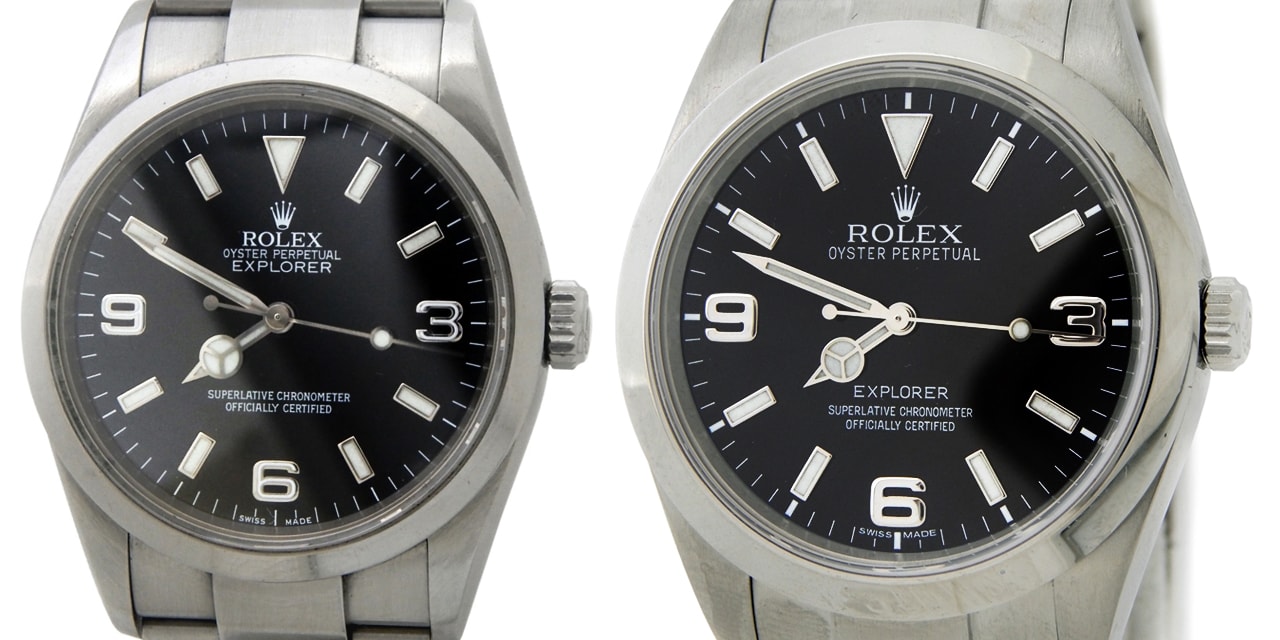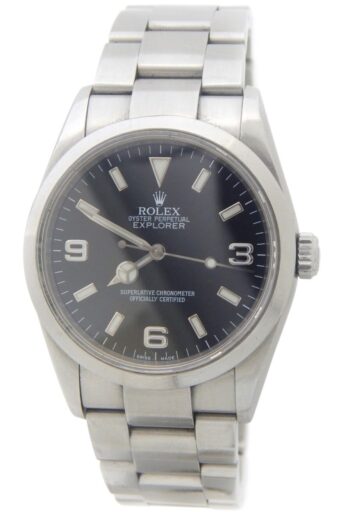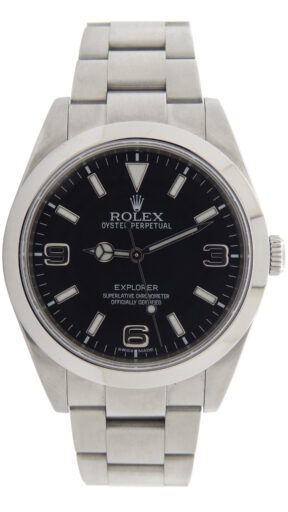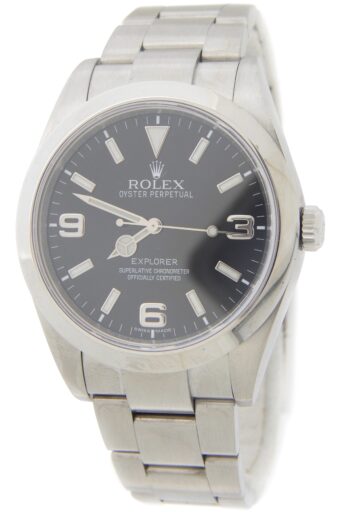The BeckerTime Guide to the Rolex Explorer
Is it fair to point at Rolex’s humble, visually-efficient Explorer as the place where it really all started?
Although the brand had been in business for nearly half a century before it arrived, it could be argued that it was the Explorer which marked the first truly major turning point in Rolex’s long and winding road, and the one which set them on their way to the uppermost echelons of the industry’s hierarchy.
Born on the summit of Earth’s highest peak, it has a legitimate claim to being the opening salvo in a new genus of timepiece, one which Rolex themselves invented; the tool watch. And while it might stretch that description by its modern definition, few watches short of Omega’s Speedmaster have been subjected to a more forbidding proving ground.
Today, it remains perhaps the subtlest example in the manufacture’s portfolio; the non-head turner, the refined, ever-present classic for those in the know.
A Little History
With the possible exception of the GMT-Master, there are no other Rolex watches with backstories as well-known as the Explorer.
The marketing genius that was brand founder Hans Wilsdorf realized early on in his career at the helm that persuading the most prominent figures of the day—those performing extraordinary feats of endurance, bravery or, yes, exploration—to wear his watches would do more to bring his products to the notice of the general public than any slick advertising campaign could ever hope to emulate.
It started with the English Channel swims of Mercedes Gleitze, was carried on by the likes of Sir Malcolm Campbell with his land speed records attempts and, by the 1930s, had turned to that last great unconquered pinnacle of human endeavor, Mount Everest.
Rolex watches were worn by the crews of the Houston-Everest Expedition, the first to successfully fly over the mountain’s summit at an altitude exceeding 10,000ft. As a sponsor of the attempt, Rolex supplied watches utilizing the two innovations with which the brand had revolutionized not only the industry but the image of the wristwatch itself, the Oyster case and the Perpetual movement. Expedition organizer Lieutenant-Colonel Stewart Blacker recorded, ‘I can hardly imagine that any watches have ever been subjected before to such extremes under practical conditions. In spite of all this, the watches continued to work with the utmost accuracy… Not the slightest fault could be found with them.’
Soon after, Rolex became a backer of the maiden attempts at scaling the mountain on foot, and would underwrite eight unsuccessful efforts before 1953.
That was the year a young New Zealander named Edmund Hillary made his bid, alongside Nepalese Sherpa Tenzing Norgay.
The seven-week trek ended in triumph as the two men reached the peak on 29th May at 11.30am, the time recorded by Hillary on his Rolex Oyster.
That watch, now in the possession of the Beyer Watch & Clock Museum in Zurich, was provided to the climbers on the condition it would be returned to Rolex for extensive testing when (or if) the men made a safe descent. To his eternal credit, that was precisely what Hillary did (I would have made an excuse and kept it, personally) and the information gleaned from the watch that had seen the top of the world formed the basis for the initial Explorer.
The debut reference, however, is a cause of some discussion. The first time we see the name Explorer appear is on the ref. 6150. Yet, it only appears on the later examples of the model, the early specimens saying merely ‘Precision’, to indicate that it was not chronometer-rated. All do have the signature 3/6/9 dial indexes which are indicative of the Explorer proper though, leading to some pragmatists splitting the difference and referring to the ref. 6150 as a ‘Pre-Explorer’.
It was the follow-up, the ref. 6350, which really set the tone the entire series has followed right into the modern age. 36mm, steel, with the cardinal Arabic numerals and a chronometer-rated caliber, every unit of the ref. 6350 wore the ‘Explorer’ text on its jet black dial. It was, as is its contemporary equivalent, the epitome of the discerning gentleman’s sports watch; a stark, time-only three-hander and a timeless anti-fashion statement for doers rather than talkers.
So refined was the design, in fact, that it has barely altered since the mid-20th century.
By 1960, after a couple more short-lived references which did little more than tweak what was already present, Rolex released the ref. 1016…and didn’t feel the need to revisit the Explorer again for another 29-years. Short of an update or two to the movement and a swap from gilt to matte dials at the end of the ‘60s, the ref. 1016 from the beginning of its run was practically identical to one from the end.
Even the next iteration which took over in 1989 was a near-carbon copy. The ref. 14270, while it might have had a high beat movement and applied numerals on a new glossy dial, was unavoidably of the same ilk as all of its predecessors. It was only in 2010, following the updated ref. 114270 (which just changed the engine) that any kind of noteworthy alteration came in. The 214270 bumped up the dimensions to 39mm for the first time, bringing a more contemporary size to the old warhorse.
It lasted a mere decade or so however. In 2021, the current generation of the Explorer emerged. Or, should I say, generations. At the same time as Rolex decided to return to the time-honored 36mm dimensions, they also brought out a Rolesor alternative, in a move anticipated by literally no one. Even more unexpected, 2023 saw a 40mm example join the range marking the first time in its 70-year history that the watch has offered a choice in either size or metal.
Today, the Explorer sits in the catalog in its usual spot—one of those charming, ever-present dark horses with echoes of Rolex’s true origins. A name with absolutely nothing to prove, it is still the go anywhere, do anything stalwart from yesteryear.
But which one is right for you?
If You Want the Real Bond Watch
The Rolex Explorer ref. 1016
We all know that the first Rolex we see 007 wear is the Big Crown Submariner ref. 6538 in 1962’s Dr. No.
However, in Ian Fleming’s series of novels, the literary character of James Bond also wears a Rolex although the exact model is never specified. But, as Fleming himself habitually wore an Explorer ref. 1016, it stands to reason that was the watch the author had in mind while crafting his stories.
And in truth, it is the embodiment of an ex-Naval intelligence officer’s timepiece. On top of it being extremely robust and as unfailingly accurate as any Rolex, there is something implacably, almost stubbornly unassuming about the ref. 1016, as if it is doing everything it can to go unnoticed. At the same time, it conveys elegance and exquisite good taste to those well-acquainted enough with the marque to know what they are looking at. It is, in short, a class act.
Because the reference was in production for such a long time, 29-years start to finish, there is no shortage of examples on the preowned market to tempt your wallet, and perhaps the best news is that some are almost suspiciously affordable. Later stage watches from the ‘80s with matte dials can be had for as little as $12,000. Obviously, you can spend a lot more depending on rarity, with early 1960s specimens, with those wonderful warm gilt faces and tritium lume, costing well up in the $50-$60k range. Similarly, those which have been rendered unique by a sun-faded dial, sometimes known as Tropical dials, or co-branded with the likes of Tiffany & Co. also carry a hefty premium.
The ref. 1016 Explorer was a reference that Rolex once struggled to sell. Nowadays, it has become something of the darling of serious vintage watch collectors.
If You Want the Perfect Marriage Between Vintage and Modern
The Rolex Explorer ref. 114270
To demonstrate just how little Rolex felt the need to tamper with the Explorer, the ref. 114270 was unveiled in 2001 and represents only the fifth generation of the model (sixth, if you count the Pre-Explorer ref. 6150).
That’s just five separate references in nearly half a century, and the first three all came out in the 1950s!
True to form, there was very little to choose between the ref. 114270 and its immediate predecessor, the ref. 14270, just as there were far more similarities between that iteration and the ref. 1016 before it.
We have a stainless steel, 36mm case. An austere, time-only black dial with the unmistakable 3/6/9 indexes. We have the Oyster bracelet and the Mercedes hands. And that’s about it, because that’s all the watch has ever needed since the beginning.
What did differ from the previous generation was the inclusion of a more modern caliber in the shape of the Cal. 3130, the addition of solid end links on the bracelet and the former 316L steel making way for the newer, shinier 904L.
In that way, the ref. 114270 manages to be the best of both worlds; holding onto all the contemporary conveniences while still having the look and feel of a true vintage piece.
And as if all that wasn’t enough, the reference also constitutes the gateway to Explorer ownership, with superb examples available to buy for as little as $7,000.
If You Want a Bit More Explorer For Your Money
The Rolex Explorer ref. 214270
2010 saw some of Rolex’s most recognizable and longstanding names receive the biggest shakeups of their existence.
Both the Submariner and GMT-Master II launched new collections outfitted with the brand’s Super Case and Maxi Dial, giving them bigger and bolder stances to belatedly capture the watch buying audience’s lust for larger and larger models.
As for the Explorer, the ref. 114270 was replaced with the ref. 214270, an iteration which, to the surprise of just about everyone, increased the age-old 36mm diameter case size for a 39mm one.
For many, it was long overdue, with the Explorer being ostensibly a tool watch, and the extra mills certainly looked good on it.
Unfortunately it wasn’t around for long. Rolex retired the ref. 214270 in 2021 and returned to a 36mm diameter, and then supplemented that with the current 40mm model as well.
So there are not as many examples on the preowned market as others, singling the reference out as a possible investment opportunity down the line.
Even though it was here and gone relatively quickly, the ref. 214270 still managed to go through two different dial Marks. The MK I lasted from 2010 to 2016 and can be easily identified by their Arabic numerals. For some reason, Rolex used uncoated white gold for the iconic numbers, with no luminescent paint. They also took the handset from the 36mm model, meaning they look slightly on the short side for the bigger dial.
From 2016 to the end of the run we have the MK II which addressed both issues, with the 3/6/9 receiving lashings of Chromalight and a refreshed handset reaching all the way to the minute track.
As you might expect, those discrepancies are reflected in the price for the two versions. MK I models can be had for $8,000 or so while MK II pieces generally start at around $10,000.
But whichever you choose, you get just a little more Explorer for your buck.
Featured Photo: BeckerTime’s Archive.










